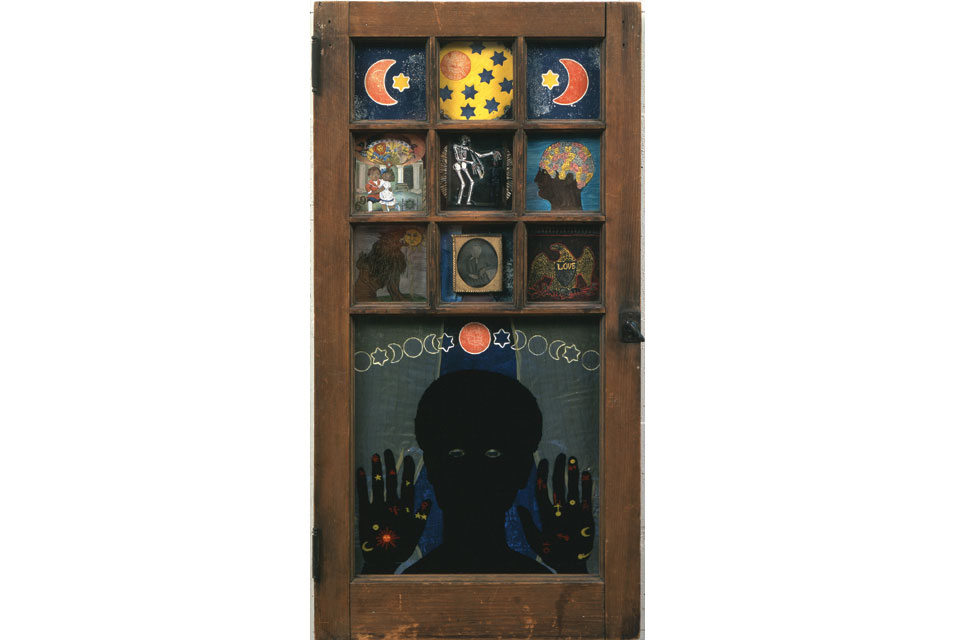
Betye Saar. Black Girl’s Window, 1969. Assemblage in window. 35 3⁄4 x 18 x 1 1⁄2 in. (90.8 x 45.7 x 3.8 cm). Collection of the artist; Courtesy of Michael Rosenfeld Gallery, LLC, New York.
LONG ISLAND CITY, NY.- MoMA PS1 presents Now Dig This! Art and Black Los Angeles 1960–1980, a comprehensive exhibition that chronicles the vital legacy of the african american artistic community in Los Angeles, examining a pioneering group of black artists whose work, connections, and friendships with other artists of varied ethnic backgrounds helped shape the creative output of Southern California. Now Dig This! Art and Black Los Angeles 1960-1980 will be on view in the First Floor Main galleries at MoMA PS1 from October 21, 2012 through March 11, 2013.
Now Dig This! is organized by the Hammer Museum, Los Angeles and was presented there in 2011-12 as part of Pacific Standard Time, a collaboration of more than sixty cultural institutions across Southern California. The exhibition is curated by Kellie Jones, Associate Professor in the Department of Art History and Archaeology, Columbia University, and the presentation at MoMA PS1 is organized at MoMA PS1 by Christophe Cherix, The Abby Aldrich Rockefeller Chief Curator of Prints and Illustrated Books, The Museum of Modern Art, and Peter Eleey, Curator, MoMA PS1, in association with Connie Butler, The Robert Lehman Foundation Chief Curator of Drawings, the Museum of Modern Art. The exhibition presents 140 works by thirty-three artists active during this historical period, exploring the rising strength of the black community in Los Angeles as well as the increasing political, social, and economic power of african americans across the nation. Several prominent artists began their careers in the Los Angeles area, including Melvin Edwards, David Hammons, Maren Hassinger, Senga Nengudi, John Outterbridge, Noah Purifoy, and Betye Saar.
Their influence, like that of all the artists in the exhibition, goes beyond their immediate creative circles and the geography of Los Angeles and is critical to a more complete and dynamic understanding of twentieth-century American art. By illuminating the richness and complexity of this creative community, Now Dig This! demonstrates how these artists were not working in isolation but were instead integral to the developing U.S. art scene during the latter part of the twentieth century. During this important era of artistic and cultural ferment, artists shifted from more traditional formats, such as painting and works on paper, to modes such as assemblage, Finish Fetish (a West Coast movement parallel to Minimal Art on the East Coast), Postminimal Art, Conceptual Art, and performance. EXHIBITION DESCRIPTION Presented in MoMA PS1’s First Floor Main galleries, Now Dig This! looks at the period through several framing categories. FRONT RUNNERS — By the early 1960s the West Coast became highly visible among the international arts community. african american artists such as Betye Saar and Melvin Edwards made some of their earliest important works during this time. Charles White, a veteran social realist from Chicago, arrived in Los Angeles from New York in 1956, energizing the black art community and inspiring many young artists who studied under him at Otis Art Institute. ASSEMBLING — The Watts Rebellion of 1965 was the largest urban riot at that time in U.S. history and had a profound effect on this community of artists. Many began to approach their craft and materials differently, and assemblage emerged as an important artistic strategy. Noah Purifoy and John T. Riddle, for example, made assemblage works from the detritus of the Watts Rebellion, creating formally impressive pieces that were also highly charged politically.
Purifoy claimed that it was the Rebellion that made him a real artist. ARTISTS/GALLERISTS — Lacking representation in mainstream institutions, african american artists opened their own venues in the 1960s and 70s. Spaces such as Gallery 32, founded by painter Suzanne Jackson, and the Brockman Gallery—established by brothers Dale and Alonzo Davis, became sites for cutting-edge work and havens for discussions, poetry readings, and fund-raisers for social causes. Samella Lewis is an amazing one-woman institution, having opened several galleries and a museum, started a magazine, and published some of the earliest books on this cohort of artists. POSTMINIMAL ART AND PERFORMANCE — This section of the exhibition documents the move away from more didactic subject matter toward abstract and dematerialized practices. Fred Eversley was the most visible african american working with the Finish Fetish style of Los Angeles Minimal Art in the 1960s.
In the 1970s artists such as Senga Nengudi, Maren Hassinger, and David Hammons began to experiment with PostMinimal Art ephemerality, and performance. LOS ANGELES SNAPSHOT / FRIENDS — The exhibition also explores the informal relationships between african american artists in Los Angeles and those in Northern California, like Raymond Saunders, as well as artists of varied ethnic backgrounds, such as Virginia Jaramillo, Ron Miyashiro, and Mark di Suvero. These relationships are an important part of fully understanding and contextualizing the work of this generation.
More Information: http://artdaily.com/index.asp?int_sec=2&int_new=58440&b=african%20american#.UITLM1FQjRY[/url]
Copyright © artdaily.org
